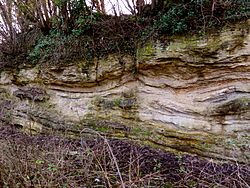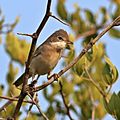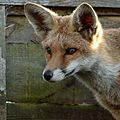Quarry Moor facts for kids
| Site of Special Scientific Interest | |

Former quarry face at Quarry Moor
|
|
| Area of Search | North Yorkshire |
|---|---|
| Coordinates | 54°07′06″N 1°31′34″W / 54.1182°N 1.5260°W |
| Interest | Biological |
| Area | 7.5927 hectares (0.07593 km2; 0.02932 sq mi) |
| Notification | 1 May 1986 |
| Location map | Defra Magicmap |
Quarry Moor is a special nature spot near Ripon, North Yorkshire, England. It's called a Site of Special Scientific Interest, or SSSI. This means it's a place that's protected because it has rare plants, animals, or rocks.
At Quarry Moor, you can see ancient rocks called Magnesian Limestone. These rocks were formed about 255 million years ago. Back then, this area was covered by a warm, tropical sea! Over time, the mud and shells from the sea floor turned into the limestone we see today.
In 1945, a kind mayor named Alderman Thomas Fowler Spence gave this land to the people of Ripon. It became an SSSI in 1986 because its special grassy areas, called calcareous grassland, are home to many different kinds of plants. One very rare plant found here is the thistle broomrape.
Quarry Moor is both a protected nature reserve and a place for people to enjoy. There's a fenced-off area for the special grass and plants. But you can also find a car park, information signs, a children's play area, easy-to-use paths, benches, and dog waste bins.
Contents
A Look Back in Time: Quarry Moor's History
The rocks you see at Quarry Moor tell a story from 255 million years ago. They are what's left of a coastline from the ancient Zechstein Sea. Over millions of years, the mud and sand from this tropical sea turned into the Magnesian Limestone that makes up this area.
People have been digging up limestone here for at least 600 years! This stone was used to build things. For example, in the 1400s, the walls of the old Chapel of St Mary Magdalen in Ripon were rebuilt using limestone from Quarry Moor. Later, in the 1870s, there were even special ovens called lime kilns here. They made quicklime from the limestone, which was used to make mortar for building.
In the 1940s, the land was used for army training. A botanist (plant expert) named George Taylor visited and was worried. He saw that a rare plant, the lady's tresses orchid, was disappearing because of the digging. Sadly, by 1944, most of the plants were gone. Today, this orchid is still very rare in northern UK.
The quarry stopped working in the 1950s. In the 1970s, the big holes left by the quarry were filled in by the British Army. Sometimes, holes called sinkholes appear in this area. This happens because there's a soft rock called gypsum mixed with the limestone. When water dissolves the gypsum, it leaves empty spaces that can sometimes collapse.
Thomas Fowler Spence: The Kind Donor
Quarry Moor is now looked after for the people of Ripon. This is thanks to Alderman T.F. Spence, who gave the land in 1945. He wanted it "to be kept for Ripon children for all time." Thomas Fowler Spence (1878–1949) was the Mayor of Ripon from 1927 to 1929. He also ran a company that made varnish.
Where is Quarry Moor and Why is it Special?
Quarry Moor nature reserve covers about 7.59 hectares. It's a special place because of its "species-rich calcareous grassland" (chalky grassland). This grassland grows on a thin layer of soil over limestone rock. The site also has some scrub (bushes) and woodland areas.
You can find Quarry Moor at the southern edge of Ripon. The main entrance is near the A61 roundabout. Inside, you'll find information boards, paths that are easy to walk on, benches, and dog toilet bins. There's also a special fenced-off area for wildflowers and a children's play area with a car park.
Quarry Moor was officially named an SSSI on May 1, 1986. It's important because its chalky grassland supports so many different plant species. The most important features are the rare thistle broomrape plant and the chalky grassland itself. In 2001, it was also named a Local Nature Reserve.
Quarry Moor gets money from groups like Natural England and Harrogate Borough Council. A local committee, made up of Ripon City councillors and public members, helps take care of the site.
Amazing Plants at Quarry Moor
Flora: A World of Plants
In the chalky grassland, you'll find many interesting plants. Some common grasses are sheep's fescue and meadow oat-grass. Among these, you might spot colorful flowers like rough hawkbit, hoary plantain, purging flax, and thyme. Other beautiful flowers include red bartsia, centaury, yellow-wort, the amazing bee orchid, and felwort.
In other grassy areas, the soil is less chalky, so plants can grow even taller. Here, you might see common spotted-orchid, great burnet, restharrow, marjoram, cowslip, hay rattle, greater burnet-saxifrage, basil, cross-wort, ox-eye daisy, knapweed, self-heal, lady's bedstraw, bird's-foot trefoil, and primrose.
In the wooded parts, under trees like sycamore, wych elm, yew, and ash, you might find goldilocks and sanicle. More common plants in these areas are dog's mercury, hairy St John's-wort, and wood avens.
Amazing Animals at Quarry Moor
Fauna: Wildlife Visitors and Residents
The bushes at Quarry Moor are perfect places for birds to nest. You might see summer visitors like the whitethroat and willow warbler, who fly all the way from Africa! Other birds that live here all year round include the treecreeper, wren, and blackcap. There's even a special spot with a bird feeding station and a bird hide where you can watch them.
Insects also love Quarry Moor. Look out for the bright yellow brimstone butterfly and the six-spot burnet moth. This moth loves to eat the bird's-foot trefoil plant. You might also spot some mammals like deer, voles, weasels, and even foxes roaming around.
Taking Care of Quarry Moor
The most important part of Quarry Moor for its SSSI status is the limestone grassland. This special grass area supports many different plants and animals, including some rare ones. To keep it healthy, people need to stop tall, thick grass and bushes from taking over. If they did, the special plants wouldn't have enough space or light.
To help, they sometimes let ponies, cattle, and special sheep like Hebrideans graze there in winter. This helps keep the grass short and creates a mix of tall and short plants. This mix is great for all the different creatures that live there. They also cut the hay in the traditional way. It's important not to use fertilizer, because the plants that grow on limestone grassland are used to living in places with not many nutrients.
Images for kids















